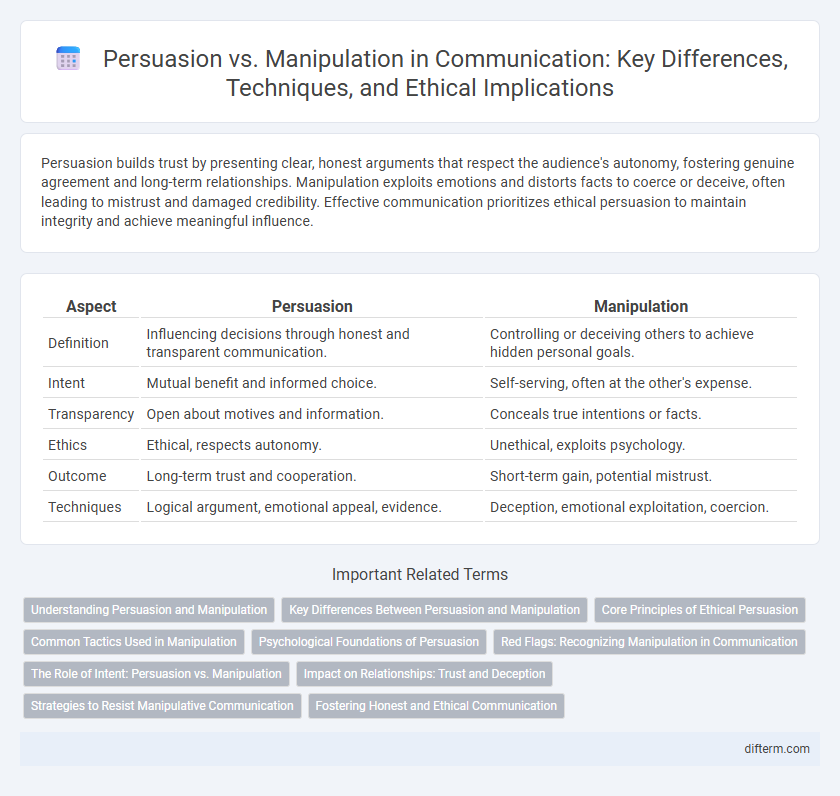Persuasion builds trust by presenting clear, honest arguments that respect the audience's autonomy, fostering genuine agreement and long-term relationships. Manipulation exploits emotions and distorts facts to coerce or deceive, often leading to mistrust and damaged credibility. Effective communication prioritizes ethical persuasion to maintain integrity and achieve meaningful influence.
Table of Comparison
| Aspect | Persuasion | Manipulation |
|---|---|---|
| Definition | Influencing decisions through honest and transparent communication. | Controlling or deceiving others to achieve hidden personal goals. |
| Intent | Mutual benefit and informed choice. | Self-serving, often at the other's expense. |
| Transparency | Open about motives and information. | Conceals true intentions or facts. |
| Ethics | Ethical, respects autonomy. | Unethical, exploits psychology. |
| Outcome | Long-term trust and cooperation. | Short-term gain, potential mistrust. |
| Techniques | Logical argument, emotional appeal, evidence. | Deception, emotional exploitation, coercion. |
Understanding Persuasion and Manipulation
Understanding persuasion involves recognizing it as a communication process aimed at influencing attitudes or behaviors through ethical appeals and transparent arguments. Manipulation, by contrast, employs deceptive tactics and exploits psychological vulnerabilities to control or coerce an audience without regard for their best interests. Distinguishing between these methods is critical for developing responsible communication strategies that foster trust and credibility.
Key Differences Between Persuasion and Manipulation
Persuasion involves transparent communication aimed at influencing others by appealing to reason and shared values, fostering trust and voluntary agreement. Manipulation relies on deceptive tactics or emotional exploitation to control outcomes, often undermining the autonomy of the individual. Key differences lie in intent, ethical considerations, and the respect for the audience's freedom to choose.
Core Principles of Ethical Persuasion
Ethical persuasion relies on honesty, transparency, and respect for the audience's autonomy, ensuring messages are truthful and intentions clear. Core principles include providing accurate information, fostering mutual benefit, and encouraging informed decision-making without coercion or deception. Maintaining these standards builds trust and sustains long-term relationships in effective communication.
Common Tactics Used in Manipulation
Common tactics used in manipulation include exploiting emotional triggers, such as guilt or fear, to influence decision-making and behavior. Manipulators often employ deceptive language, half-truths, and withholding critical information to create confusion and control outcomes. Techniques like gaslighting, false promises, and strategic flattery further undermine trust and autonomy, distinguishing manipulation from genuine persuasion.
Psychological Foundations of Persuasion
Persuasion relies on ethical psychological principles such as social proof, reciprocity, and consistency to influence attitudes and behaviors through transparent communication. It engages cognitive processes by appealing to the audience's values, beliefs, and emotions without compromising autonomy. Manipulation, in contrast, exploits psychological vulnerabilities to induce compliance through deception or coercion, undermining trust and informed decision-making.
Red Flags: Recognizing Manipulation in Communication
Recognizing manipulation in communication involves identifying red flags such as inconsistent messaging, pressure tactics, or emotional exploitation aimed at controlling decisions. Manipulators often distort facts or use excessive flattery to bypass rational judgment, contrasting ethical persuasion based on transparency and respect. Awareness of these warning signs protects individuals from covert influence and maintains integrity in interpersonal interactions.
The Role of Intent: Persuasion vs. Manipulation
Persuasion relies on transparent communication aimed at influencing others through logical reasoning and ethical appeal, fostering mutual understanding and respect. Manipulation, in contrast, involves deceptive tactics and hidden motives to control or exploit the audience for selfish gain. The role of intent distinguishes persuasion as a legitimate tool of communication from manipulation, which undermines trust and autonomy.
Impact on Relationships: Trust and Deception
Persuasion builds trust by encouraging transparent communication and respecting the audience's autonomy, fostering long-term positive relationships. Manipulation undermines trust through deception and hidden motives, often causing damage and resentment in interpersonal connections. Understanding the ethical distinction between these approaches is crucial for maintaining healthy and authentic communication.
Strategies to Resist Manipulative Communication
Recognizing emotional appeals and logical fallacies is essential in resisting manipulative communication, empowering individuals to maintain critical thinking and autonomy. Developing assertive communication skills and setting clear personal boundaries prevent undue influence and promote transparent dialogue. Building awareness of common manipulation tactics like gaslighting or guilt-tripping enhances one's ability to evaluate messages objectively and respond effectively.
Fostering Honest and Ethical Communication
Fostering honest and ethical communication requires distinguishing persuasion, which respects autonomy and presents information transparently, from manipulation, which exploits emotions and withholds truth for selfish gains. Ethical communicators build trust by prioritizing clarity, accountability, and mutual respect in their messaging. Upholding these standards encourages meaningful dialogue and sustainable relationships based on integrity.
persuasion vs manipulation Infographic

 difterm.com
difterm.com